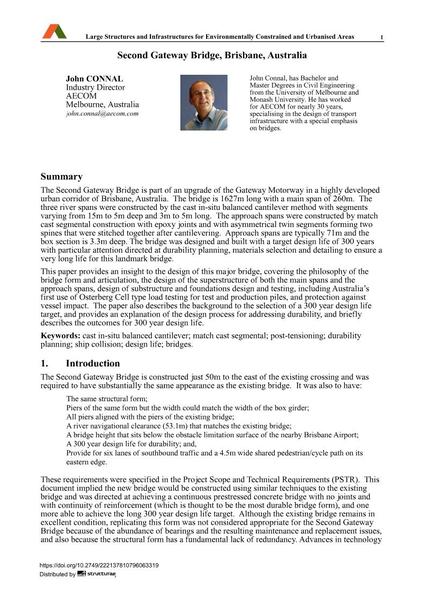Second Gateway Bridge, Brisbane, Australia

|
|
|||||||||||
Détails bibliographiques
| Auteur(s): |
John Connal
|
||||
|---|---|---|---|---|---|
| Médium: | papier de conférence | ||||
| Langue(s): | anglais | ||||
| Conférence: | IABSE Symposium: Large Structures and Infrastructures for Environmentally Constrained and Urbanised Areas, Venice, Italy, 22-24 September 2010 | ||||
| Publié dans: | IABSE Symposium Venice 2010 | ||||
|
|||||
| Page(s): | 706-707 | ||||
| Nombre total de pages (du PDF): | 8 | ||||
| Année: | 2010 | ||||
| DOI: | 10.2749/222137810796063319 | ||||
| Abstrait: |
The Second Gateway Bridge is part of an upgrade of the Gateway Motorway in a highly developed urban corridor of Brisbane, Australia. The bridge is 1627m long with a main span of 260m. The three river spans were constructed by the cast in-situ balanced cantilever method with segments varying from 15m to 5m deep and 3m to 5m long. The approach spans were constructed by match cast segmental construction with epoxy joints and with asymmetrical twin segments forming two spines that were stitched together after cantilevering. Approach spans are typically 71m and the box section is 3.3m deep. The bridge was designed and built with a target design life of 300 years with particular attention directed at durability planning, materials selection and detailing to ensure a very long life for this landmark bridge. This paper provides an insight to the design of this major bridge, covering the philosophy of the bridge form and articulation, the design of the superstructure of both the main spans and the approach spans, design of substructure and foundations design and testing, including Australia’s first use of Osterberg Cell type load testing for test and production piles, and protection against vessel impact. The paper also describes the background to the selection of a 300 year design life target, and provides an explanation of the design process for addressing durability, and briefly describes the outcomes for 300 year design life. |
||||
| Mots-clé: |
ponts
|
||||
